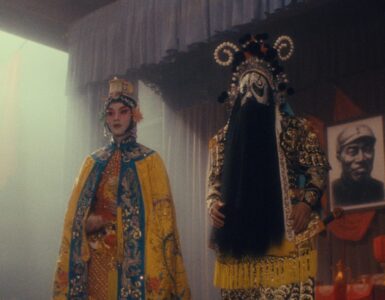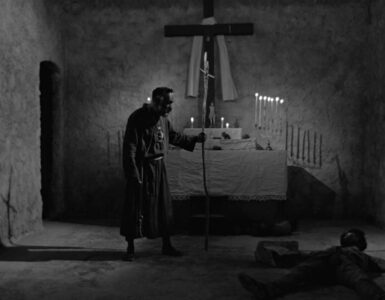Occasionally, especially when talking about films released on DVD and Blu-ray from The Criterion Collection, a release can seemingly fall through the cracks. Monthly, the company releases top notch motion pictures, legendary classics and the curve ball, unsung masterpiece, tossed in for good measure. And with a regular schedule for the releases they put into the ether at the lower, $10 lower to be exact, price point, the chances for a bewildering masterwork to blind side you is rather high. However, they may not get the time of day they so rightly deserve.
One release that is as intriguing as any they’ve given us in quite some time, particularly at the discounted price tag, is their recently released DVD and Blu-ray of Fritz Lang’s rarely seen paranoia noir, Ministry Of Fear.
Made during a point in Lang’s career that would see him, just a few years after this 1944 picture, give the world such pictures as Scarlet Street and The Blue Gardenia (as well as things like the unsung Western Rancho Notorious). The film follows a man named Stephen Neale who, upon our first meeting him, we see that he is being freshly released from a stint in a mental institution.
However, with WWII raging in England, he is released into a world that is not only rife with danger, but danger that hits closer to home than ever. Lang’s contrast-heavy noir finds its lead stumbling upon a Nazi spy plot that turns this film from just another standard 40’s Nazi-centric noir picture, into a film that is as visceral and aesthetically entrancing as one would expect from a director like Lang, at the very top of his game.
Based on a novel from Graham Greene, Lang’s picture is one of the director’s most underrated works. Released during one of the director’s many career high points (hell, that very year would also see the release of Lang’s equally underrated The Woman In The Window), and this is no different. Steeped heavily in a sense of stark paranoia that would not only find its way into various Lang films but also become pervasive throughout ‘40s cinema the film finds Lang at the very height of his directorial powers. Clocking in at under 90 minutes, the film is a percussively taut thriller that relies as much on its lighting, set design and photography as anything from the period. Very much aesthetically influenced by the German Expressionism that made things like Lang’s Mabuse pictures the genre defining noir features that they would become, the film is an absolute Masters class in the ability of lighting to not only effect mood in a feature film, but also its ability to ostensibly become the major aesthetic player in the said film. Think Hitchcock’s various man on the run films but tossed through a blender controlled by Dr. Caligari. The black and white photography here is made up of seemingly just that, pitch blacks and hot whites, and Lang’s camera is playful, with the various chase/action set pieces holding their own as powerful pieces of cinema even today. There is a particular series, involving a train and a handful of explosives that feels as white knuckle tense as anything we’ve seen in any blockbuster the last handful of years. It’s seriously a superbly made bit of noir that is as tense as it is taut, as thrilling as it is visually striking.
Cast wise, the film has one big time star in its collection of superb thespians. Ray Milland stars here as Stephen Neale, and he steals the show. Seton I. Miller’s screenplay is admittedly a great bit of writing to play off of, but his performance is as perfect an everyman bit of noir acting that one could ever seen. An Oscar winner in the making (he’d go on to win for his all-time great turn in Wilder’s Lost Weekend), Milland proves himself as a truly great actor here, playing off the screenplay perfectly, a bit of writing that is both tense and oddly comedic. A story ostensibly about a collection of people with their sights set on a troublesome cake that may or may not hold within its frosty perfection a cavalcade of Nazi secrets, the film itself is slightly off from its very outset, but Milland’s performance really grounds it with his sense of realism and a really stark sense of truth. A love interest (played by Marjorie Reynolds) is tossed in for good measure, and their chemistry adds even more narrative intrigue to a picture that already isn’t all that hard pressed to gain one’s attention.
Now, with little to no supplements of note on this, or any of Criterion’s lower-priced DVD and Blu-ray releases, what is the selling point for this film? Outside of it being a great film, one will come for the name Fritz Lang, but ultimately stay because of how truly breathtaking this film’s new restoration and transfer (particularly for the Blu-ray) really is. With every black, every white, and every hue in between looking as crisp and powerful as it did nearly 70 years ago, the transfer absolutely pops off the screen. There is a definitively noir haze and murky sheen to the film that is heightened with this new restoration, ultimately making this yet another top notch transfer given to an underrated Criterion Collection home video release. Glenn Kenny gives a great essay to a small insert here, and an interesting, if all too short, video interview with Lang scholar Joe McElhaney adds a bit of context to a truly great release.
Would a commentary have been a great addition? Sure. However, one would be hard pressed to find anything to truly complain about when this unsung noir masterpiece is given yet another day in the spotlight, hopefully sparking an interest in this type of picture for an all new generation.







![Bergman Island (The Criterion Collection) [Blu-ray]](https://criterioncast.com/wp-content/uploads/2022/11/bergman-island-the-criterion-collection-blu-ray-400x496.jpg)
![This Is Not a Burial, It’s a Resurrection (The Criterion Collection) [Blu-ray]](https://criterioncast.com/wp-content/uploads/2022/11/this-is-not-a-burial-its-a-resurrection-the-criterion-collection-blu-ray-400x496.jpg)
![Lars von Trier's Europe Trilogy (The Criterion Collection) [The Element of Crime/Epidemic/Europa] [Blu-ray]](https://criterioncast.com/wp-content/uploads/2022/11/lars-von-triers-europe-trilogy-the-criterion-collection-the-element-of-400x496.jpg)
![Imitation of Life (The Criterion Collection) [Blu-ray]](https://criterioncast.com/wp-content/uploads/2022/11/imitation-of-life-the-criterion-collection-blu-ray-400x496.jpg)
![The Adventures of Baron Munchausen (The Criterion Collection) [4K UHD]](https://criterioncast.com/wp-content/uploads/2022/11/the-adventures-of-baron-munchausen-the-criterion-collection-4k-uhd-400x496.jpg)
![Cooley High [Criterion Collection] [Blu-ray] [1975]](https://criterioncast.com/wp-content/uploads/2022/11/cooley-high-criterion-collection-blu-ray-1975-400x496.jpg)